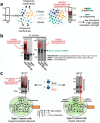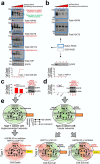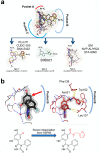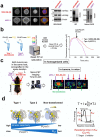Chaperome heterogeneity and its implications for cancer study and treatment
- PMID: 30409908
- PMCID: PMC6369301
- DOI: 10.1074/jbc.REV118.002811
Chaperome heterogeneity and its implications for cancer study and treatment
Abstract
The chaperome is the collection of proteins in the cell that carry out molecular chaperoning functions. Changes in the interaction strength between chaperome proteins lead to an assembly that is functionally and structurally distinct from each constituent member. In this review, we discuss the epichaperome, the cellular network that forms when the chaperome components of distinct chaperome machineries come together as stable, functionally integrated, multimeric complexes. In tumors, maintenance of the epichaperome network is vital for tumor survival, rendering them vulnerable to therapeutic interventions that target critical epichaperome network components. We discuss how the epichaperome empowers an approach for precision medicine cancer trials where a new target, biomarker, and relevant drug candidates can be correlated and integrated. We introduce chemical biology methods to investigate the heterogeneity of the chaperome in a given cellular context. Lastly, we discuss how ligand-protein binding kinetics are more appropriate than equilibrium binding parameters to characterize and unravel chaperome targeting in cancer and to gauge the selectivity of ligands for specific tumor-associated chaperome pools.
Keywords: 70 kilodalton heat shock protein (Hsp70); biomarker; cancer biology; cancer therapy; chaperome; chaperone; chemical biology; chemical probes; epichaperome; heat shock protein 90 (Hsp90); protein networks; stress response.
© 2019 Wang et al.
Conflict of interest statement
G. C. has partial ownership in Samus Therapeutics Inc., which develops epichaperome inhibitors
Figures






Similar articles
-
The epichaperome is an integrated chaperome network that facilitates tumour survival.Nature. 2016 Oct 20;538(7625):397-401. doi: 10.1038/nature19807. Epub 2016 Oct 5. Nature. 2016. PMID: 27706135 Free PMC article.
-
Chaperome Networks - Redundancy and Implications for Cancer Treatment.Adv Exp Med Biol. 2020;1243:87-99. doi: 10.1007/978-3-030-40204-4_6. Adv Exp Med Biol. 2020. PMID: 32297213 Free PMC article. Review.
-
A Chemical Biology Approach to the Chaperome in Cancer-HSP90 and Beyond.Cold Spring Harb Perspect Biol. 2020 Apr 1;12(4):a034116. doi: 10.1101/cshperspect.a034116. Cold Spring Harb Perspect Biol. 2020. PMID: 30936118 Free PMC article. Review.
-
Paradigms for Precision Medicine in Epichaperome Cancer Therapy.Cancer Cell. 2019 Nov 11;36(5):559-573.e7. doi: 10.1016/j.ccell.2019.09.007. Epub 2019 Oct 24. Cancer Cell. 2019. PMID: 31668946 Free PMC article.
-
Selective targeting of the stress chaperome as a therapeutic strategy.Trends Pharmacol Sci. 2014 Nov;35(11):592-603. doi: 10.1016/j.tips.2014.09.001. Epub 2014 Sep 25. Trends Pharmacol Sci. 2014. PMID: 25262919 Free PMC article. Review.
Cited by
-
Chemical probes and methods for single-cell detection and quantification of epichaperomes in hematologic malignancies.Methods Enzymol. 2020;639:289-311. doi: 10.1016/bs.mie.2020.04.057. Epub 2020 May 10. Methods Enzymol. 2020. PMID: 32475406 Free PMC article.
-
Heat Shock Proteins Are Essential Components in Transformation and Tumor Progression: Cancer Cell Intrinsic Pathways and Beyond.Int J Mol Sci. 2019 Sep 11;20(18):4507. doi: 10.3390/ijms20184507. Int J Mol Sci. 2019. PMID: 31514477 Free PMC article. Review.
-
Capturing the conversion of the pathogenic alpha-1-antitrypsin fold by ATF6 enhanced proteostasis.Cell Chem Biol. 2023 Jan 19;30(1):22-42.e5. doi: 10.1016/j.chembiol.2022.12.004. Epub 2023 Jan 10. Cell Chem Biol. 2023. PMID: 36630963 Free PMC article.
-
Chemical tools for epichaperome-mediated interactome dysfunctions of the central nervous system.Nat Commun. 2021 Aug 3;12(1):4669. doi: 10.1038/s41467-021-24821-2. Nat Commun. 2021. PMID: 34344873 Free PMC article.
-
The epichaperome is a mediator of toxic hippocampal stress and leads to protein connectivity-based dysfunction.Nat Commun. 2020 Jan 16;11(1):319. doi: 10.1038/s41467-019-14082-5. Nat Commun. 2020. PMID: 31949159 Free PMC article.
References
-
- Wang X., Venable J., LaPointe P., Hutt D. M., Koulov A. V., Coppinger J., Gurkan C., Kellner W., Matteson J., Plutner H., Riordan J. R., Kelly J. W., Yates J. R. 3rd., and Balch W. E. (2006) Hsp90 co-chaperone Aha1 downregulation rescues misfolding of CFTR in cystic fibrosis. Cell 127, 803–815 10.1016/j.cell.2006.09.043 - DOI - PubMed
-
- Brehme M., Voisine C., Rolland T., Wachi S., Soper J. H., Zhu Y., Orton K., Villella A., Garza D., Vidal M., Ge H., and Morimoto R. I. (2014) A chaperome subnetwork safeguards proteostasis in aging and neurodegenerative disease. Cell Rep. 9, 1135–1150 10.1016/j.celrep.2014.09.042 - DOI - PMC - PubMed
Publication types
MeSH terms
Substances
Grants and funding
LinkOut - more resources
Full Text Sources

